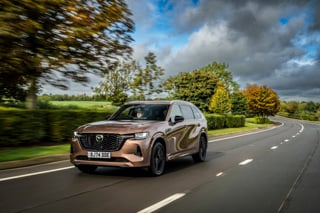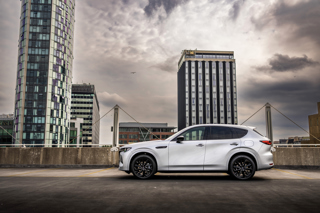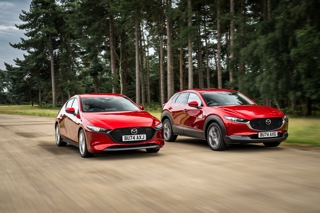Mazda has grown its fleet sales consistently by double digits for the past three years. In 2012, it registered just 6,447 after two years of significant decline; last year that had risen to around 12,800.
Now, with its youngest ever model line-up, and one of the youngest in the motor industry, the company has set a more modest target, forecasting fleet growth of 5-6%.
Head of fleet Steve Tomlinson says this is in line with the broader business aspirations and is partly down to stock availability. “We could probably do more with the CX products but we can’t get any more,” he says.
Last year saw facelifts to the CX-5 and Mazda 6, and new launches for the Mazda 2, CX-3 and MX-5. All will play their part in securing more fleet business as Mazda aims for 13,600 registrations this year.
Fleet will still account for a below-market-average proportion of 28% (the industry average is 54%) with total sales slated to hit 49,000.
The Fleet News Award-winning CX-3 is starting to make an impact, with fleets registering more than 700 last year – exactly the total that Mazda forecast to Fleet News at the car’s media launch a year ago.
This year, Mazda is planning to sell 5,324 units, described by Tomlinson as “modest” due to high global demand for cars, of which 23% (1,225) is planned for fleet.
“Whilst we would love to be able to sell more, it isn’t bad news as we anticipate residual values (RVs) to remain strong compared to some of the competition; and the car will no doubt be in high demand as a used car as a result,” he says.
Fleet News: Your fleet sales were up in 2015, but a lot of this was down to rental, which was up 337%/2,130 units at 2,761. Why was this, and what are your plans for 2016?
Steve Tomlinson: In 2014, all of our rental was at the back end of the year; we did nothing in the first nine months. That was the point at which we re-engaged with rental and 2015 was at a similar level with the fourth quarter of 2014. We had an opportunity to take additional production – rental is good for when cars break down; we want to put someone in a Mazda. Most of the volume goes through one partner for car hire.
We will see a similar level in 2016 as 2015. We are careful not to affect our overall business mix or position in the market.
We have to be focused on where and how we sell. Around 55% of our fleet volume is contract hire and leasing, and in Motability we only sell 2, 3 and 6 – no CX. We have devised our volume plan and then we go to market to deliver it – no more, no less. As a consequence, we can react to market changes.
Our mantra is ‘sustainable and repeatable business’. It’s an approach which supports RVs and ensures we have long-term relationships with our partners.
FN: The majority of your fleet business is with user-chooser and perk fleets. Do you plan to do more with job-need?
ST: This year we are looking for new business wins and organic growth with existing customers. Our 1.5-litre 99g/km Mazda 3 will open doors to fleets that want engines below two litres. We can look after any size of fleet but we do better with user-choosers. We have very few job-need fleets and that is often because we don’t have a wide trim level for base models. We only have three trims so we don’t tend to end up at the lower end of the market on price. But the benefit-in-kind (BIK) message is important. Our teams have to be aware of the specification and trim levels of our competitors when comparing on lease rates. Our entry model could be much better equipped than rivals which might appear cheaper on paper.
FN: Mazda has not ventured down the electric vehicle route so far; what is the company’s view on the future for engine technology?
ST: We took the decision some time ago to pursue improvements to the internal combustion engine (ICE), rather than go electric or hybrid. We have made up to 30% in improvements in the efficiency and emissions of the ICE and believe there is at least that level of improvement to come.
Once we have these efficient engines then we can look at hybrid systems, but with a lower level of electrification to ensure we retain the fun-to-drive elements of ICE. We do have a hybrid in Japan in the Mazda 3; this is on sale but we have no plans to export outside Japan. We also have an electric programme, but we will not introduce a fully electric car in the near future.
FN: What role does your dealer network play in fulfilling fleet and company car driver needs, and what are you doing to improve this service?
ST: As a brand, we are keen to support the profitability of our dealer network as much as possible and as such ensure that every fleet car that we sell is supplied by the network. As things stand we have six fleet specialist dealers, out of a network of 136, and the end user and contract hire volume is split approximately 50:50 between these two groups.
In terms of local businesses, we provide the network with a strong programme to enable them to offer Mazda products via contract hire at a competitive price and also the tools to sell to local businesses which opt to outright purchase their vehicles.
FN: How are the expectations of fleets changing in the way they interact with you?
ST: Their expectations have increased and this is our focus for this year – we want to improve our customer service position in the UK. We will launch our aftersales fleet charter which will set out exactly what a leasing company, fleet manager or company car driver can expect from a servicing and repair perspective and this will be promoted via our website and by the fleet team once live. It won’t necessarily change what we offer, but it will formalise it and give them recourse if they don’t get it, like a guarantee of service levels. All the network will sign up to it.
FN: What do you see as the biggest challenge facing fleets today – and how can Mazda help them overcome it?
ST: As there will always be a focus on the costs of running a fleet, ensuring that they are up to speed with vehicle taxation legislation and how that impacts on their vehicle choice is something that should be reviewed regularly, not only from the perspective of cost to the business but also from the perspective of the driver, in terms of BIK. Mazda is well aware of this fact. Ensuring that our cars are not only well specified but also offer drivers a competitive BIK cost has always been a top priority.
Mazda is continuing to invest in its fleet operations, appointing an additional contract hire manager last year.
It is also putting great emphasis on the new 1.5-litre engine which, in addition to the Mazda 3, will also go into the Mazda 2 and CX-3. Tomlinson is confident that the quoted figures are achievable and says there has been extensive real-life testing.
He adds: “We let our technology do the job on emissions more than reducing the engine size.”
So far this year, Mazda is well on track to achieve its growth aspirations, with true fleet sales up 14.5% in the first three months while rental has fallen by just over 12%.
























Login to comment
Comments
No comments have been made yet.